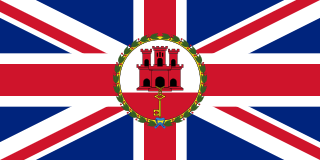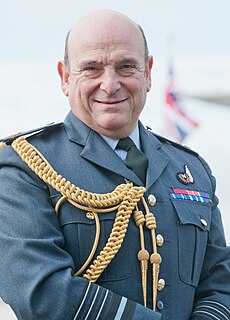
Marshal of the Royal Air Force Sir Dermot Alexander Boyle, was a senior officer in the Royal Air Force. He served in the Second World War initially as a staff officer with the Advanced Air Striking Force in Reims in which capacity he organised the evacuation of the Force through Brest in May 1940. His war service included tours as a bomber squadron commander, as a station commander and also as an air group commander. He was Chief of the Air Staff in the late 1950s and, in that role, deployed British air power during the Suez Crisis in October 1956 and defended the RAF against the views of Duncan Sandys, the Minister for Defence, who believed that the V bomber force rendered manned fighter aircraft redundant.

Marshal of the Royal Air Force Sir Thomas Geoffrey Pike, was a senior officer in the Royal Air Force. He served in the Second World War as a night fighter squadron commander and then as a station commander. He was Chief of the Air Staff in the early 1960s and, in that role, deployed British air power as part of the British response to the Brunei Revolt. Also, in the face of escalating costs, he implemented the cancellation of the British Blue Streak ballistic missile system but then found the RAF was without any such capability when the Americans cancelled their own Skybolt ballistic missile system. He went on to be Deputy Supreme Commander Supreme Headquarters Allied Powers Europe in the mid-1960s.

Marshal of the Royal Air Force Samuel Charles Elworthy, Baron Elworthy, was a senior officer in the Royal Air Force. He served as commander of a squadron of Blenheim bombers and then as a station commander during the Second World War. He became Chief of the Air Staff in the mid-1960s and implemented the cancellation of the TSR-2 strike aircraft and the HS681 military transport aircraft programmes. He also became Chief of the Defence Staff in which role he oversaw the evacuation from Aden in November 1967 and had to respond to the growing crisis in Northern Ireland in the late 1960s.

Marshal of the Royal Air Force Sir John Grandy, was a senior officer in the Royal Air Force. He was the only officer who fought and commanded a squadron during the Battle of Britain to reach the post of Chief of the Air Staff. In the latter role he implemented the final stages of the RAF's withdrawal from the Persian Gulf and the Far East, oversaw the ordering and subsequent cancellation of the F-111 strike aircraft and handed over Britain's nuclear deterrent role to the Royal Navy.
Air Chief Marshal Sir David George Evans, was a senior commander of the Royal Air Force.
Group Captain Paul Ward Spencer Bulman,, universally known as George Bulman, was a pilot whose flying life spanned thirty years (1915–1945).

Air Chief Marshal Sir Charles Stuart Burnett, was a senior commander in the Royal Air Force during the first half of the 20th century. He was Air Officer Commanding Iraq Command during the early 1930s. During the Second World War, he served as Chief of the Air Staff of the Royal Australian Air Force.

Vice Admiral Sir Adrian James Johns, is a former senior officer in the Royal Navy, serving as Second Sea Lord between 2005 and 2008. He was the Governor of Gibraltar between 2009 and 2013.
Air Commodore Graham Clarke Bladon was a British air officer of the Royal Air Force, who initially joined the Royal Naval Air Service during the First World War, becoming an RAF officer in 1918. He went on to hold various commands up to and throughout the Second World War, and served as the first Commander of the Royal Ceylon Air Force from 1951 until 1958.
Dudley Vivian Peyton-Ward was a Royal Navy officer who served in both the First World War and during and after the Second World War.

Air Chief Marshal Sir Stuart William Peach, is a senior Royal Air Force officer. After training as a navigator, Peach commanded IX (Bomber) Squadron and then became Deputy Station Commander RAF Bruggen. He was deployed as NATO Air Commander (Forward) in Kosovo in 2000. He went on to be Chief of Defence Intelligence in 2006, Chief of Joint Operations in 2009 and the first Commander of Joint Forces Command in December 2011 before being appointed Vice-Chief of the Defence Staff in May 2013. Peach succeeded General Sir Nick Houghton as Chief of the Defence Staff on 14 July 2016. He succeeded General Petr Pavel as Chairman of the NATO Military Committee on 29 June 2018, serving as such until his retirement from NATO in June 2021.

Air Commodore Raymond James Brownell, was a senior officer in the Royal Australian Air Force (RAAF) and a First World War flying ace. Born in Hobart, Tasmania, Brownell was working as a clerk with a firm of accountants when he enlisted in the Australian Imperial Force on the outbreak of the First World War. He served during the Gallipoli Campaign before transferring to the Western Front. Awarded the Military Medal for his actions during the Battle of Pozières, he was accepted for a transfer to the Royal Flying Corps in 1917. Brownell undertook flight training in the United Kingdom. Commissioned as a second lieutenant, he was posted for operational service over the Western Front in September 1917. Moving with his squadron to Italy, he was awarded the Military Cross and credited with shooting down 12 aircraft by war's end. Taking his discharge in 1919, Brownell returned to Australia.

Air Chief Marshal Sir Andrew Douglas Pulford, is a retired senior Royal Air Force (RAF) commander. A helicopter pilot with operational service in Northern Ireland, the Falklands War and Iraq War, Pulford commanded RAF Odiham and No. 2 Group, and served as Assistant Chief of Defence Staff Operations, before taking up the post of Deputy Commander-in-Chief Personnel at Air Command and Air Member for Personnel in 2010. He became Chief of the Air Staff on 31 July 2013, retiring from the Royal Air Force on 12 July 2016.
Group Captain Frank Andrew Willan, was an English aviator, Royal Air Force officer and Conservative politician. He was Chairman of Wiltshire County Council from 1973 to 1979.

Air Vice Marshal George Stacey Hodson, was an air officer of the British Royal Air Force who began his military career as a World War I flying ace credited with ten aerial victories. In the course of his 34 years service, he rose to become a major commander during World War II.

Air Vice Marshal Frank Headlam, was a senior commander in the Royal Australian Air Force (RAAF). Born and educated in Tasmania, he joined the RAAF as an air cadet in January 1934. He specialised in flying instruction and navigation before the outbreak of World War II. In April 1941, he became commanding officer of No. 2 Squadron, which operated Lockheed Hudsons. The squadron was deployed to Dutch Timor in December, and saw action against Japanese forces in the South West Pacific. After returning to Australia in February 1942, Headlam held staff appointments and training commands, finishing the war a group captain.
Air Commodore Allen Henry Wheeler was a Royal Air Force officer and pilot who served during the Second World War. He was later trustee of the Shuttleworth Trust, a collection of vintage cars and aircraft.
Air-Vice Marshal Thomas Geoffrey Bowler was a senior Royal Air Force officer.

Captain Frederick Stovin-Bradford was a Royal Navy officer and aviator in the Fleet Air Arm. During his career, Stovin-Bradford was involved in the sinking of the Italian submarine Iride, was one of the youngest officers to be promoted to the rank of captain since Nelson's time, and served as Staff Officer to the Flag Officer of Home Air Command in England and later Chief Staff Officer to the Flag Officer in charge of East Australia. His obituary in The Times described him as one of the most colourful personalities in the Fleet Air Arm.
Air Commodore Michael Paul Crotty, .,, , usually referred to as Paul Crotty, is a retired senior Royal Air Force Commander and Aerospace director.











